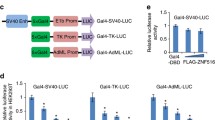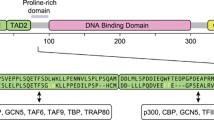Abstract
Zinc finger protein 703 (ZNF703) is a putative oncogene in patients with the luminal B molecular subtype of breast cancer. Although the exact function of ZNF703 protein remains largely unknown, its expression and regulation have been implicated in several physiological and pathological processes. In the current study, for the first time, we identified and characterized the human ZNF703 gene promoter region. As a means of characterizing the transcription elements required for expression of ZNF703 protein at different stages, we cloned the promoter region of ZNF703 then created chimeric reporter plasmids for use in luciferase assays. A progressive deletion analysis of the ZNF703 gene’s 5′ and 3′ -flanking regions revealed that the core promoter is located in a 256-bp region ranging from nt-539 to nt-283. Next, we examined the effects of site-specific mutations and treatment with mithramycin A to identify the functional Sp1 binding site, which was found to be located in a 447 bp region that ranged from nt-509 to nt-76, displayed the characteristics of a CpG island, and overlapped with the promoter region. In conclusion, our data suggest that ZNF703 transcription is regulated by transcription factor Sp1. This finding should facilitate future studies of the mechanism which regulates expression of this important gene.




Similar content being viewed by others
Abbreviations
- ANOVA:
-
Analysis of variance
References
Bazarov AV, Yaswen P (2011) Who is in the driver’s seat in 8p12 amplifications? ZNF703 in luminal B breast tumors. Breast Cancer Res 13:308
Briggs MR, Kadonaga JT, Bell SP, Tjian R (1986) Purification and biochemical characterization of the promoter- specific transcription factor, Sp1. Science 234:47–52
Bucher P (1990) Weight matrix descriptions of four eukaryotic RNA polymerase II promoter elements derived from 502 unrelated promoter sequences. J Mol Biol 212:563–578
Castro-Rivera E, Samudio I, Safe S (2001) Estrogen regulation of cyclin D1 gene expression in ZR-75 breast cancer cells involves multiple enhancer elements. J Biol Chem 276:30853–30861
Chin K, DeVries S, Fridlyand J, Spellman PT, Roydasgupta R, Kuo WL, Lapuk A, Neve RM, Qian Z, Ryder T et al (2006) Genomic and transcriptional aberrations linked to breast cancer pathophysiologies. Cancer Cell 10:529–541
Curtis C, Shah SP, Chin SF, Turashvili G, Rueda OM, Dunning MJ (2012) The genomic and transcriptomic architecture of 2000 breast tumours reveals novel subgroups. Nature 486:346–352
Dorfman R, Glazer L, Weihe U, Wer NET MF, Shilo BZ (2002) Elbow and Noc define a family of zinc finger proteins controlling morphogenesis of specific tracheal branches. Development 129:3585–3596
Duan R, Porter W, Safe S (1998) Estrogen-induced c-fos protooncogene expression in MCF-7 human breast cancer cells: role of estrogen receptor Sp1 complex formation. Endocrinology 139:1981–1990
Dynan WS, Tjian R (1983) The promoter-specific transcription factor Sp1 binds to upstream sequences in the SV40 early promoter. Cell 35:79–87
Eriksson N, Benton GM, Do CB, Kiefer AK, Mountain JL, Hinds DA, Francke U, Tung JY (2012) Genetic variants associated with breast size also influence breast cancer risk. BMC Med Genet 30(13):53
Garcia MJ, Pole JC, Chin SF, Teschendorff A, Naderi A, Ozdag H, Vias M, Kranjac T, Subkhankulova T, Paish C et al (2005) A 1 Mb minimal amplicon at 8p11-12 in breast cancer identifies new candidate oncogenes. Oncogene 24:5235–5245
Gerasimova E, Audit B, Roux SG, Khalil A, Gileva O, Argoul F, Naimark O, Arneodo A (2014) Wavelet-based multifractal analysis of dynamic infrared thermograms to assist in early breast cancer diagnosis. Front Physiol 8(5):176
Hartgrink HH, Jansen EP, van Grieken NC, van de Velde CJ (2009) Gastric cancer. Lancet 374:477–490
Haverty PM, Fridlyand J, Li L, Getz G, Beroukhim R, Lohr S, Wu TD, Cavet G, Zhang Z, Chant J (2008) High-resolution genomic and expression analyses of copy number alterations in breast tumors. Genes Chromosom Cancer 47:530–542
Holland DG, Burleigh A, Git A, Goldgraben MA, Perez-Mancera PA, Chin SF, Hurtado A, Bruna A, Ali HR, Greenwood W et al (2011) ZNF703 is a common luminal B breast cancer oncogene that differentially regulates luminal and basal progenitors inhuman mammary epithelium. EMBO Mol Med 3:167–180
Hosoi Y, Watanabe T, Nakagawa K, Matsumoto Y, Enomoto A, Morita A, Nagawa H, Suzuki N (2004) Up-regulation of DNA-dependent protein kinase activity and Sp1 in colorectal cancer. Int J Oncol 25:461–468
Ji SJ, Periz G, Sockanathan S (2009) Nolz1 is induced by retinoid signals and controls motoneuron subtype identity through distinct repressor activities. Development 136:231–240
Kadonaga JT, Courey AJ, Ladika J, Tjian R (1988) Distinct regions of Sp1 modulate DNA binding and transcriptional activation. Science 242:1566–1570
Letovsky J, Dynan WS (1989) Measurement of the binding of transcription factor Sp1 to a single GC box recognition sequence. Nucleic Acids Res 17:2639–2653
Liao X, Deng W, Lu Y, Tao D, Liu Y, Zhang S, Ma Y (2010) Sp1 plays an important role in regulating the transcription of ZNF313. Cell Biol Int 34(9):901–905
Ma F, Bi L, Yang G, Zhang M, Liu C, Zhao Y, Wang Y, Wang J, Bai Y, Zhang Y (2014) ZNF703 promotes tumor cell proliferation and invasion and predicts poor prognosis in patients with colorectal cancer. Oncol Rep 32:1071–1077
Nakamura M, Runko AP, Sagerström CG (2004) A novel subfamily of zinc finger genes involved in embryonic development. J Cell Biochem 93:887–895
Ngwenya S, Safe S (2003) Cell context-dependent differences in the induction of E2F-1 gene expression by 17b-estradiol in MCF-7 and ZR-75 cells. Endocrinology 144:1675–1685
Pereira-Castro I, Costa AM, Oliveira MJ, Barbosa I, Rocha AS, Azevedo L, da Costa LT (2013) Characterization of human NLZ1/ZNF703 identifies conserved domains essential for propersubcellular localization and transcriptional repression. J Cell Biochem 114:120–133
Philipsen S, Suske G (1999) A tale of three fingers: The family of mammalian Sp/XKLF transcription factors. Nucleic Acids Res 27:2991–3000
Reynisdottir I, Arason A, Einarsdottir BO, Gunnarsson H, Staaf J, Vallon-Christersson J, Jonsson G, Ringnér M, Agnarsson BA, Olafsdottir K et al (2013) High expression of ZNF703 independent of amplification indicates worse prognosis in patients with luminal B breast cancer. Cancer Med 2:437–446
Runko AP, Sagerstrom CG (2004a) Nlz belongs to a family of zinc-finger-containing repressors and controls segmental gene expression in the zebrafish hindbrain. Dev Biol 262:254–267
Runko AP, Sagerstrom CG (2004b) Isolation of nlz2 and characterization of essential domains in Nlz family proteins. J Biol Chem 279:11917–11925
Shi Q, Le X, Abbruzzese JL, Peng Z, Qian CN, Tang H, Xiong Q, Wang B, Li XC, Xie K (2001) Constitutive Sp1 activity is essential for differential constitutive expression of vascular endothelial growth factor in human pancreatic adenocarcinoma. Cancer Res 61:4143–4154
Shi Y, Li J, Liu Y, Ding J, Fan Y, Tian Y, Wang L, Lian Y, Wang K, Shu Y (2015) The long noncoding RNA SPRY4-IT1 increases the proliferation of human breast cancer cells by up regulating ZNF703 expression. Mol Cancer 14:1–13
Sircoulomb F, Nicolas N, Ferrari A, Finetti P, Bekhouche I, Rousselet E, Lonigro A, Adélaïde J, Baudelet E, Esteyriès S et al (2011) ZNF703 gene amplification at 8p12 specifies luminal B breast cancer. EMBO Mol Med 3:153–166
Slorach EM, Chou J, Werb Z (2011) Zeppo1 is a novel metastasis promoter that represses E-cadherin expression and regulates p120-catenin isoform expression and localization. Genes Dev 25:471–484
Sørlie T, Perou CM, Tibshirani R, Aas T, Geisler S, Johnsen H, Hastie T, Eisen MB, van de Rijn M, Jeffrey SS et al (2001) Gene expression patterns of breast carcinomas distinguish tumor subclasses with clinical implications. Proc Natl Acad Sci USA 98:10869–10874
Sørlie T, Tibshirani R, Parker J, Hastie T, Marron JS, Nobel A, Deng S, Johnsen H, Pesich R, Geisler S et al (2003) Repeated observation of breast tumor subtypes in independent gene expression data sets. Proc Natl Acad Sci USA 100:8418–8423
Spellman P, Gray J (2011) A new treasure in the breast cancer gene hunt. Nat Med 17:422–423
Suske G (1999) The Sp-family of transcription factors. Gene 238:291–300
Vyhlidal C, Samudio I, Kladde M, Safe S (2000) Transcriptional activation of transforming growth factor a by estradiol: requirement for both a GC-rich site and an estrogen response element half-site. J Mol Endocrinol 24:329–338
Wang W, Dong L, Saville B, Safe S (1999) Transcriptional activation of E2F1 gene expression by 17b-estradiol in MCF-7 cells is regulated by NF-Y-Sp1/estrogen receptor interactions. J Mol Endocrinol 13:1373–1387
Xu W, Zhang S, Qiu W, He G, Liu Y, Sun Y, Ma Y, Dong J, Zhang W (2009) Spermatogenesis-related ring finger ZNF230 promoter: identification and functional analysis. Mol Biol Rep 36:1187–1193
Yang G, Ma F, Zhong M, Fang L, Peng Y, Xin X, Zhong J, Yuan F, Gu H, Zhu W et al (2014) ZNF703 acts as an oncogene that promotes progression in gastric cancer. Oncol Rep 31:1877–1882
Yao JC, Wang L, Wei D, Gong W, Hassan M, Wu TT, Mansfield P, Ajani J, Xie K (2004) Association between expression of transcription factor Sp1 and increased vascular endothelial growth factor expression, advanced stage, and poor survival in patients with resected gastric cancer. Clin Cancer Res 10:4109–4117
Zhang X, Mu X, Huang O, Xie Z, Jiang M, Geng M, Shen K (2013) Luminal breast cancer cell lines overexpressing ZNF703 are resistant to tamoxifen through activation of Akt/mTOR signaling. PLoS ONE 8:e72053
Acknowledgements
We thank the Department of Medical Genetics of Sichuan University for generously providing plasmids for creating the pGL3-vector, and also for providing the HEK293T cell line.
Funding
This study was funded by the Sichuan Provincial Education Projects [nos. 15ZB0443].
Author contributions
Xiaolin Liao and Sheng He designed the study, Xiaolin Liao and Yongjie Lu conducted the experiments, Junbao Yang, Tao Kuang, Xiaoli Zhou, Bo Jiang, Huiqun Kang and Yanjun Wang analyzed the data, and Xiaolin Liao and Lilin Jiang wrote the manuscript.
Author information
Authors and Affiliations
Corresponding author
Ethics declarations
Conflict of interest
Xiaolin Liao declares that she has no conflict of interest. Yongjie Lu declares that he has no conflict of interest. Junbao Yang declares that he has no conflict of interest. Tao Kuang declares that she has no conflict of interest. Lilin Jiang declares that she has no conflict of interest. Yanjun Wang declares that she has no conflict of interest. Huiqun Kang declares that she has no conflict of interest. Bo Jiang declares that she has no conflict of interest. Xiaoli Zhou declares that she has no conflict of interest. Sheng He declares that he has no conflict of interest.
Ethical approval
This study was approved by ethics committees of West China Hospital, Sichuan University.
Informed consent
Written informed consent was obtained from participant.
Rights and permissions
About this article
Cite this article
Liao, X., Lu, Y., Yang, J. et al. Transcription factor Sp1 is necessary and functional in regulating expression of oncogene ZNF703 . Genes Genom 39, 1107–1115 (2017). https://doi.org/10.1007/s13258-017-0577-9
Received:
Accepted:
Published:
Issue Date:
DOI: https://doi.org/10.1007/s13258-017-0577-9




